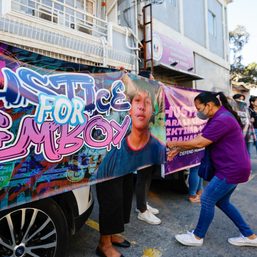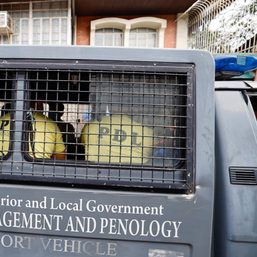SUMMARY
This is AI generated summarization, which may have errors. For context, always refer to the full article.
![[OPINION] Really defunding and abolishing the police](https://www.rappler.com/tachyon/2023/08/imho-defundingpolice.jpg)
The violent killing of Jemboy Baltazar by police officers was not the first instance of the violence of policing, especially within the context of former President Duterte’s war on drugs that also claimed the life of Kian delos Santos. Indeed, Filipinos are still being killed under Marcos Jr.’s war on drugs. However, we have an opportunity now to make sure that there are no more victims of the state’s apparatus of violence and policing. After all the death in the past decade, it is time to defund and abolish the police.
Calls to defund and abolish the police are not new. In 2017, Teddy Casiño argued to abolish the Philippine National Police (PNP). In 2020, after an off-duty cop murdered mother and son Sonya Gregorio and Frank Gregorio, calls to abolish the PNP proliferated on social media. More proposals were put forward after a cop killed Lilybeth Valdez in 2021. However, these proposals are flawed in that they called to merely abolish the PNP and replace it with a reconstituted police force. This is not police abolition as abolitionists call for it because these proposals merely replace one kind of police with another while the social relations of policing and its violence remain. After all, the dreaded Philippine Constabulary was replaced by the PNP, yet the inherent violence of policing remained. When abolitionists call for police abolition, they mean that the abolition of policing as a social relationship comprising of practices based on social control and the use of force that is empowered and legitimized by — usually but not limited to — the state.
Abolitionists understand that policing is violent by design. The PNP is not bulok [rotten], because for something to be rotten, it must have had spoiled from an earlier clean state. However, the police was never pristine for there was never a time when policing and incarceration were not violent. Indeed, the violence of policing has always consistently emerged to do violence against an underclass. In the United States, police emerged as slave-catching patrols. Across the world, colonial powers used the police to control conquered populations and its effectiveness prompted European states to create police forces domestically. This was the case in the Philippines where the Spanish colonial state created the Guardia Civil to maintain its rule. During American colonization, the American colonial police was so effective at social control that policing was imported back to the United States, even after slavery and its police institutions were abolished. The American colonial police became the post-independence Philippine Constabulary that was eventually used to implement martial law.
“But who would keep us safe if there were no police?” A better question to ask is: “Does the police actually keep us safe right now?” Or perhaps: “Why is it that safety and managing harm is monopolized by an inherently violent apparatus?” The fact of the matter is that the police do not deter harm; they react to it in a violent way, by inflicting physical violence or caging someone away. Or as the oft-unreported police killings show, police often create harm itself, especially when they surveil and red-tag activists. Once the harm is done, doing more harm upon others does not produce safety, merely the illusion of safety. The root causes of why the harm occurred — systemic injustice, poverty, untreated mental illness, desperation, a patriarchal and violent upbringing — continues to persist and cannot be addressed while the person who did harm is either caged or killed. Across the world and across history, human societies had countless means to manage harm and produce safety. Today, we only have policing and the prisons. Abolitionism challenges us to question the myths and preconceptions we grow up with in a society with policing. It challenges us to think of ways to deal with harm and keeping each other safe without involving more violence.
So, what kind of reforms do we need to address the violence of policing? The problem is that the creation, institutionalization, and social reproduction of policing has monopolized our society’s ability to manage harm. Abolishing the police today without addressing the root causes of social harms would not automatically create a safer society. We need reforms, but not all reforms are made equal. “Reformist reforms” are those that further funds, entrenches, and socially reproduces the violent institution of policing. An example of this would be body cameras for police. They seem like an accountability measure, but it merely puts more money into the institutions of policing, thereby entrenching them. Besides, Jemboy was killed while body cams were turned off. Besides, there are no technological solutions to social problems. Rather, we need “non-reformist reforms” or “abolitionist steps” that interrupts the social reproduction of policing and radically decreases its scale.
Critical Resistance developed a simple test for asking if an instance of police reform entrenches the police or if it is a step towards abolishing the police. This test asks: “Does this reform (1) reduce funding to police? (2) challenge the notion that the police increases safety? (3) reduce tools, tactics, or technology police have at their disposal? (4) reduce the scale of policing?” Body cameras, community policing schemes, more training, oversight boards, and jailing killer cops all answer NO to these questions. Meanwhile, suspending the use of administrative leave for cops under investigation, withholding pensions and firing cops involved in excessive force, capping overtime pay and scrapping pay for police exercises, defunding police militarization programs and equipment, prioritizing spending on social services, and reducing the size of the police force all answers YES to these questions.
Defunding the police and funding social services that addresses multiple crises in food, health, education, housing, and child care will do more for creating safety than a thousand cops. But social services alone cannot get rid of all harm, only the harms that come from desperation and poverty. However, the funds freed from reduced policing can instead fund and allow communities to create models of community accountability like restorative and transformative justice, on focusing on how to repair and restitute harm, on creating safe spaces for perpetrators of harm to confront the root causes of harm and preventing it from happening again, and dismantling hierarchies of oppression. These transformative models of responding to harm are impossible when perpetrators of harm are merely caged, or worse, killed.
Ultimately, policing did not always exist in the Philippines; it came with colonialism. That there was a time before the police existed is proof that there could be a time that the police would no longer exist. Perhaps true decolonization also means abolishing the police. Indeed, many Indigenous communities in our country have longstanding cultural traditions of dealing and managing harm. People have been dealing with harm without the state for generations despite the hegemony of policing, not just Indigenous communities, but criminalized communities like sex workers and people who use drugs. Abolitionism does not merely mean the abolition of policing, but also the restoration of previously suppressed ways of dealing with harm and finding new ways of producing safety. Abolitionism means creating a safer and freer Philippines for all Filipinos. – Rappler.com
Lorenzo Miguel C. Cordero is affiliated with ABOLISYON!, a police and prison abolitionist affinity group. ABOLISYON! organizes mutual aid, survivor support, prisoner support, and harm reduction.
Add a comment
How does this make you feel?
![[The Slingshot] Lito Patay’s 4 hours and 38 minutes of infamy](https://www.rappler.com/tachyon/2024/07/Lito-Patay-4-hours-infamy-July-19-2024.jpg?resize=257%2C257&crop=233px%2C0px%2C720px%2C720px)

![[EDITORIAL] Hustisya sa Jemboy case: Tinimbang ka ngunit kulang](https://www.rappler.com/tachyon/2024/03/animated-jemboy-baltazar-killing-verdict-carousel.jpg?resize=257%2C257&crop=257px%2C0px%2C720px%2C720px)


![[Rappler Investigates] What’s it all about, Alice?](https://www.rappler.com/tachyon/2024/05/alice-guo-newsletter-may-30-2024.jpg?resize=257%2C257&crop=292px%2C0px%2C720px%2C720px)



![[OPINION] Drug arrest and jail and prison congestion: Search for alternatives](https://www.rappler.com/tachyon/2023/12/tl-drugs-prison.jpg?resize=257%2C257&crop=391px%2C0px%2C1080px%2C1080px)
There are no comments yet. Add your comment to start the conversation.